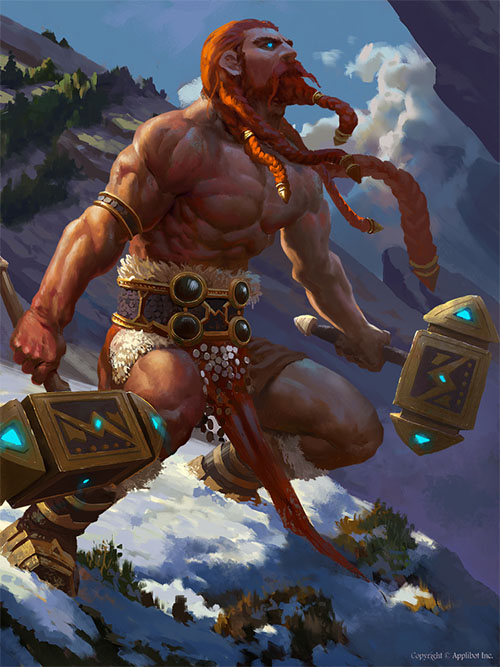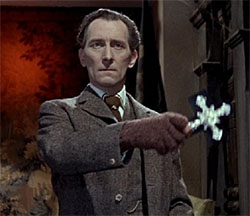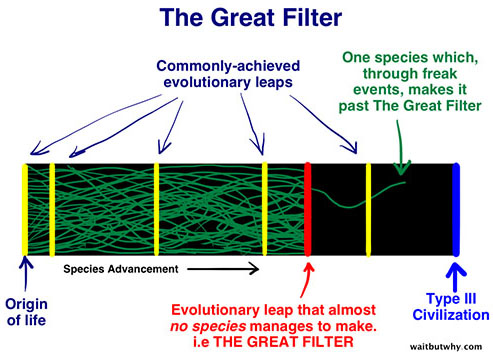In 2011 I posted the Ruined Temple of Illhan here at the Alexandrian: It’s an old school dungeon crawl based around the Neo-Norska Pantheon and the supporting mythology I created. The centerpiece of of this mythology was Illhan, the eldest son of Thor. Illhan led the Eight Sons of Thor and Three Daughters of Hel to fight the legions of Nidhogg, the Great Serpent of Shadow. He was notable for wielding a hammer in each hand and his primary holy symbol was a pair of crossed hammers.
A few days ago, I was linked to this amazing piece of art entitled “The Son of Thor”:

This isn’t a direct depiction of Illhan, the Son of Thor. (It’s some other son of Thor.) But if you were going to use the Ruined Temple of Illhan, this piece of art would be pretty cool to use.
Filed under: Roleplaying Games | Comment (0)
In a thread on the RPGsite (see post #15), Barbatruc proposes an interesting method for tracking torches and lanterns. He later mentions being inspired by Intwischa’s method for tracking ammo. Talysman drops in a little later (post #26) to mention that he does something similar with wands. (Which, I’ll note, is very similar to Numenera‘s artifact depletion roll.)
For my own reference, I’m going to archive these methods here briefly:
LIGHT SOURCES: In OD&D, set aside a d6 for each lit torch and a d24 for each lit lantern. At the beginning of each turn roll all the dice set aside: Anything that comes up 1 goes out and gets marked off the character sheet. (This results in torches and lanterns having by-the-book durations on average, but introduces an element of uncertainty and variability. More importantly, it simplifies bookkeeping.)
INTWISCHA’S AMMO: The PC has an “ammo die” of a size determined by the amount of ammunition they’re carrying. They roll this die with each attack roll and if it comes up 1, their die type decreases by one size. If they purchase ammunition or find a stash of it during the adventure, they can increase the die size instead.
ALTERNATIVE AMMO: Have your PCs buy ammo in lots equal to the die size of the system you’re using. (d20 in 3.5, for example.) When you roll a 1 on your attack roll, mark off one lot of ammo. (Trail of Cthulhu uses a similar mechanic in pulp mode, but when you roll the 1 you’re actually clicking on an empty cylinder and automatically miss. I’m ditching the “critical failure” aspect of the mechanic and just using it to track ammo.)
WANDS: Roll percentile dice. On a roll of 1 or 2, the wand has run out of charges. (Note: This system doesn’t work if you want the PCs to have some method of determining exactly how many charges are left in a wand.)
What I’m seeing here is a cluster of techniques that I think can be trivially generalized to cover any form of consumable that are likely to be carried in large quantities for frequent use. I suspect it’s particularly useful if you can incorporate it into a general resolution mechanic (instead of rolling a separate die on every single check).
Filed under: Roleplaying Games | Comments (9)
Ken Levine proffers (and comments upon) a Mike Nichols quote:
Every scene is either a fight, seduction, or negotiation.
Levine points out some caveats with the claim and Mark Evanier (who originally linked me to Levine’s piece) offers a few more, but I thought the simplicity of the fight / seduction / negotiation triad was an interesting conceptual tool when thinking about scene-framing. As I discussed in the Art of Pacing, there’s a lot of different ways you can think about the creative elements that you put into a scene and a lot of different structures you can use (or abuse)
Filed under: Roleplaying Games | Comment (1)
 DH Boggs at Hidden in Shadows has put together an absolutely fascinating bibliographic analysis of the earliest versions of the turn undead ability in D&D.
DH Boggs at Hidden in Shadows has put together an absolutely fascinating bibliographic analysis of the earliest versions of the turn undead ability in D&D.
The short version: Virtually no explanation of the “turn undead” ability was provided in the original edition of D&D. Boggs makes a strong case that the ability was only being used by Arneson’s Blackmoor group in Minneapolis and not being used by Gygax’s Greyhawk group in Lake Geneva. Gygax, therefore, gave the ability short shrift in compiling the 1974 rulebooks; this short shrift, in turn, resulted in people interpreting the ability in a way that was much more powerful than Arneson intended (or the Blackmoor group was experiencing). And the legacy of that power-up is something that the game is still dealing with 5+ editions later.
This is a great example of the “Ur-Game” of D&D, as I described it in my Reactions to OD&D several years ago.
What’s also interesting to me is how closely Boggs’ reconstruction of Arneson’s original rules mirror the house rules for turning that I posted here on the Alexandrian back in 2007. (These rules are still being regularly used in my 3.5 Ptolus campaign. And they’re great: Streamlined resolution paired with a range of effects which is less overpowered and, simultaneously, more interesting in the results it produces.)
Back to Reactions to OD&D
Filed under: Roleplaying Games | Comment (1)

Even if you’re already familiar with the Fermi Paradox, you might find it worthwhile to check out this excellent treatment of the subject. What makes it particularly worthy of attention is the comprehensive totality of the coverage, offering detailed breakdowns on more than a dozen different Fermi-related scenarios.
The Fermi Paradox is very relevant to both Eclipse Phase and The Strange, so I’ve been thinking about it a lot lately.
Filed under: Random | Comments (7)














